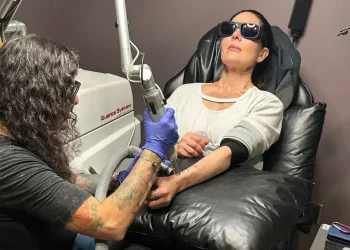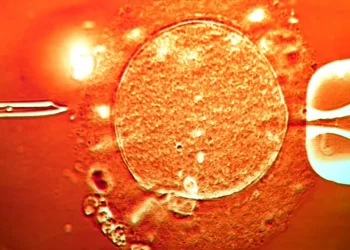Chronic Pain May Not Be All in Your Head—But the Solution Could Be There, Expert Says
Chronic pain affects millions of people, often without a clear cause. It’s one of the most invisible yet prevalent health issues, with over a quarter of Americans experiencing pain that lasts longer than three months. The economic cost of chronic pain is staggering—reaching up to $635 billion annually in the U.S. alone. Despite countless treatments, both traditional and alternative, many people still struggle to find relief.
Psychotherapist Nicole Sachs is challenging the status quo with a solution rooted in brain science and mind-body medicine. In her new book Mind Your Body: A Revolutionary Program to Release Chronic Pain and Anxiety, Sachs offers a novel approach to chronic pain and conditions like long Covid-19, migraines, fibromyalgia, and irritable bowel syndrome. Her method combines science with a unique writing practice, JournalSpeak, to release emotions and ease physical pain.
In this interview, Sachs explains how emotional stress and trauma might be at the root of your chronic pain, and how understanding your brain’s response can be the first step toward healing.
CNN: What is mind-body medicine, and how does it relate to chronic pain?
Nicole Sachs: Mind-body medicine acknowledges the powerful connection between emotional health and physical well-being. My mentor, Dr. John Sarno, discovered that chronic pain doesn’t always stem from physical injury or pathology. Instead, it often arises from emotional trauma and the nervous system’s response to stored emotions. Dr. Sarno coined the term Tension Myoneural Syndrome (TMS) to describe conditions where pain results from emotional stress rather than physical harm.
CNN: How does emotional stress lead to physical symptoms?
Nicole Sachs: Our nervous system is designed to handle basic life functions like breathing and heartbeat. Similarly, it manages our emotional world, often keeping feelings like grief, anger, and shame buried deep below the surface. While this helps us function, there comes a point when these repressed emotions bubble up, often triggered by stress or trauma. When this happens, the nervous system reacts by sending pain signals to protect us from these overwhelming emotions.
CNN: Why would the brain deliberately cause pain?
Nicole Sachs: The brain’s main job is to protect us. When emotional pain becomes too much, the brain treats it like a physical threat, triggering a fight-or-flight response. Pain serves as a protective mechanism, encouraging us to slow down and take care of ourselves, even if the pain seems unconnected to any physical injury.
CNN: Does this mean the pain isn’t real?
Nicole Sachs: The pain is very real—it’s just that the source is emotional rather than physical. The brain is responsible for all pain, whether it’s from a physical injury or emotional distress. Modern brain imaging shows that the same areas of the brain light up when someone experiences emotional pain or physical injury.
CNN: What’s the cure for this type of pain?
Nicole Sachs: The treatment I recommend involves three key components:
- Knowledge: Understanding the brain science behind chronic pain and emotional stress.
- JournalSpeak: A targeted writing practice where you unfilter your emotions for 20 minutes a day.
- Self-compassion: Being kind to yourself and practicing patience as you heal.
CNN: Can you explain what JournalSpeak is and how it works?
Nicole Sachs: JournalSpeak is a daily 20-minute writing practice that allows you to express your deepest, rawest emotions—without holding back. This helps release the emotional energy stored in your body. Once that energy is vented, your nervous system no longer feels the need to trigger pain to protect you from these emotions. After writing, you destroy the paper—it’s about release, not analysis.
CNN: How can writing down your complaints actually heal physical pain?
Nicole Sachs: Writing is a way to release the emotional energy that has transformed into physical pain. When we repress our emotions, they get stored in our body, causing discomfort. JournalSpeak acts as a pressure valve, letting that energy out so the nervous system can stop triggering pain.
CNN: Is this method limited to treating pain?
Nicole Sachs: Not at all. The principles of mind-body medicine can help with many conditions, including chronic fatigue, migraines, and autoimmune disorders. The key is that all these symptoms are caused by the nervous system’s protective response to emotional distress.
CNN: Does science back this approach?
Nicole Sachs: Yes, recent studies are showing that mind-body techniques can lead to remission of chronic symptoms. For instance, a study at Harvard Medical School showed that participants who used mind-body practices reported significantly less pain, with 64% of them pain-free six months later.
CNN: How can someone tell if their pain is related to TMS?
Nicole Sachs: First, it’s important to rule out physical causes with your doctor. If you’ve had multiple tests with no clear explanation for your pain, if your pain moves around, or if stress triggers it, these may be signs of TMS.
CNN: Will healing require me to completely change my life?
Nicole Sachs: Not at all. You don’t need to quit your job or make drastic life changes. The key is to understand and process your emotions—not necessarily remove every source of stress. The goal is to approach life with greater self-awareness and compassion.
CNN: What’s the first step in healing?
Nicole Sachs: Start with curiosity. Be compassionate with yourself, listen to your body, and trust that healing is possible. The power to heal lies in understanding the connection between your emotions and physical pain, and working with your nervous system rather than against it. The message of hope here is simple: Your body is not broken. With the right knowledge and tools, you can heal.
This article was rewritten by JournosNews.com based on verified reporting from trusted sources. The content has been independently reviewed, fact-checked, and edited for accuracy, neutrality, tone, and global readability in accordance with Google News and AdSense standards.
All opinions, quotes, or statements from contributors, experts, or sourced organizations do not necessarily reflect the views of JournosNews.com. JournosNews.com maintains full editorial independence from any external funders, sponsors, or organizations.
Stay informed with JournosNews.com — your trusted source for verified global reporting and in-depth analysis. Follow us on Google News, BlueSky, and X for real-time updates.














